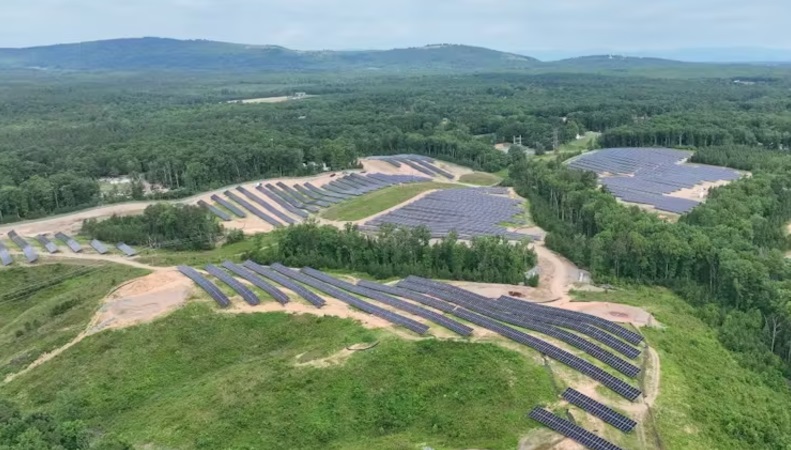|
|
|
Happy Friday!
September 12th, 2025
|
|
|
|
This week, the Energy Right team was out in King George County where we attended a public hearing on a proposed solar project, as well as travelling to Carroll and Wythe counties on our mission for clean energy, the Right Way.
|
|
|
|
|
|
|
|
Building Now, Not Waiting Decades— Virginia’s Practical Energy Solution
|
 |
|
|
|
In a recent Cardinal News column, Delegate David Reid posed a critical question: how do we bridge Virginia’s energy needs over the next 10–15 years while keeping costs low, reliability high, and emissions down? At Energy Right, we believe the answer is clear. The technologies to meet this moment already exist—utility-scale solar and battery storage. These resources can be deployed far faster than advanced nuclear or fusion, which remain years or even decades away from commercial readiness. With solar and storage, power can be delivered to the grid within 18–24 months, making them the most scalable, cost-effective tools available to meet Virginia’s surging demand.
But while the technology is ready, the real barriers are not technical—they are social, political, and regulatory. Too often, local officials face pressure from misinformation campaigns that exaggerate risks, overlook safety protocols, and downplay the economic benefits of clean energy development. As Delegate Reid rightly noted, responsible siting is essential. But today, landowners looking to lease property for energy projects increasingly encounter blanket restrictions that limit their rights and reduce Virginia’s ability to attract investment. At the same time, communities deserve to see clear, tangible benefits—like tax revenue for schools, good-paying construction jobs, and long-term investments in rural infrastructure.
Virginia has a proud history of energy innovation, from pioneering electric co-ops to hosting the nation’s first commercial SMR demonstration. But the most urgent task isn’t waiting for future breakthroughs—it’s building the solutions we already have. Solar and storage represent the bridge to a resilient, affordable, and lower-carbon grid over the next decade. To get there, we must uphold property rights, prioritize local benefits, and push back against fear with facts. If we do, Virginia can remain both economically competitive and energy secure for generations to come.
|
|
|
|
|
|
|
|
Buzz of the Week
|
|
|
 |
|
Hollyfield Solar Farm, VA
|
|
Right after loading up the panels, the bees get a little stir-crazy! With a couple hundreds of pounds of honey in the back, all that’s left is to wait for the swarming bees to settle down before the truck heads off with the haul.
|
|
|
|
Follow Us
|
|
|
|
|
|
|
|
|
|
Minimal Strain, Maximum Gain: The Case for Solar in County Revenues
|
|
|
|
|
Virginia counties are beginning to recognize the fiscal potential of utility-scale solar, particularly when projects are sited on farmland. Traditionally, land enrolled in use-value taxation generates only modest revenue for local governments, often just a few dollars per acre each year. When those same acres are developed for solar, the shift is significant.
For example, a 1,000-acre farm that might yield less than $10,000 annually in property taxes under agricultural assessment can generate well over $1 million once converted to solar. That is because projects are assessed on their infrastructure value — including panels, racking, and electrical equipment — rather than just the land itself. This effectively multiplies the tax base many times over while still leaving the land eligible for decommissioning and eventual return to agriculture.
Counties are using this revenue to strengthen schools, public safety, and infrastructure, often supplemented by siting agreements that provide direct payments beyond standard taxes. Unlike residential or commercial growth, which brings new demands for services, solar projects deliver added income with minimal strain on local resources. For rural localities with limited commercial tax bases, solar can serve as both a reliable revenue stream and a clean energy investment, creating a financial foundation for communities alongside the power they supply.
|
|
|
 |
|
A 14 Mega-Watt Solar Farm in Charlottesville, VA
|
|
|
|
|
|
|
|
|
|
Our team travelled to Carroll, Charlottesville/Albemarle, King George, and Westmoreland counties on our mission for energy done the Right Way.
|
|
|
|
|
|
|
|
|
|
On Tuesday the Energy Right team attended a public hearing in King George County regarding a 22MW utility scale project. Our team provided public comment, speaking to solar at-large. We stressed the importance of upholding landowner property rights and to look at the tax dollars that solar projects are projected to bring to the county and to consider how they can be allocated towards public services.
|
|
|
|
|
|
|
|
Virginia eyes nuclear to power booming data centers
– Virginia Business
|
|
Del. David Reid drove through Southwest Virginia to attend a community forum on nuclear energy, using the journey to explore what it will take for Virginia to meet its energy demands over the next 10-15 years.
He contrasts the long timeline and high costs of full-scale light-water reactors (like Georgia’s Vogtle) with the promise of Small Modular Reactors (SMRs) and fusion. While SMRs offer a more flexible future, no design has yet been approved in the U.S., and deployment—optimistic projections place a first 300-megawatt SMR at North Anna by 2033, but delays and regulatory hurdles could push that to 2035-2040.
Reid argues that while SMRs and fusion get much of the attention, what Virginia really needs now are scalable energy solutions that can be deployed in the next few years—ones that balance cost, reliability, and low emissions.
|
|
|
|
|
|
|
|
|
|
NEXT WEEK
We’ll be traveling to Carroll, King George, and Surry counties and more!
|
|
|
|
|
|
|
|
|
|
Virginia lawmakers are weighing how to keep power affordable as energy use surges from data centers. At a recent Commission on Electric Utility Regulation meeting, leaders debated energy efficiency, community solar, storage, and nuclear SMRs. Advocates urged more funding for low-income efficiency upgrades and even rejoining RGGI, while concerns lingered over added costs. With storage pilots underway and community solar stalled, the commission will refine legislative recommendations by December.
|
|
|
|
|
|
|

